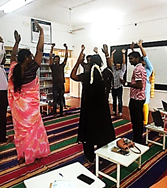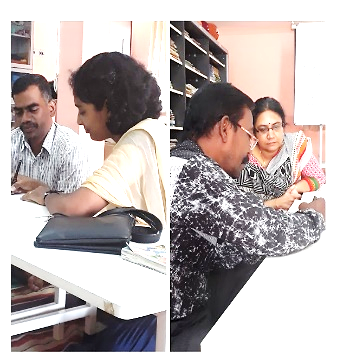Playing games in classrooms is usually considered to be a time-consuming and unproductive exercise. However, games provide opportunities for interaction and can be utilised to create a meaningful context for language learning.
A workshop highlighting the importance of games in English classrooms was conducted at Villianur ERC. The response received motivated us to re-conduct the same workshop at Mudaliarpet TRC.
The objective of this workshop is to discuss ways to make use of games in language classrooms in order to achieve the following: acquire language skills, promote creativity, and engage in democratic practices.
Such educational games can be played with students in three stages, each involving the three processes listed below:
- Eliciting language required to play the game;
- Introducing/discussing the rules of the game;
- Playing the game.
In the first stage
- Language can be elicited from the students through an activity involving the entire class.
- The teacher can inform the students about the rules of the game.
- The teacher can direct the said game.
In the second stage
- Language can be elicited from the students while making them work in groups.
- The students and their teacher can discuss and modify the rules of the game.
- The students can direct the game, while the teacher ensures that the rules are followed.
In the third stage
- Language can be elicited from the students through individual or pair work.
- The teacher and the students can discuss and modify the rules of the game, ensuring that (i) everyone is treated equally, (ii) no one gets hurt, and (iii) English language is learnt.
- The students as well as the teacher participate as players in the game, and all of them get a chance (in turns) to direct the game and ensure that the discussed rules are followed.
Let’s take the game Simon Says for example (information pertaining to the original game is available online).
First stage (whole class activity)
- The teacher asks all the students in class what actions they can perform using their hands and fingers.

The students answer in Tamil/English. The teacher writes them on the blackboard in English.
A few examples are given below:
- Wave your hands.
- Tap your head with your left hand.
- Make dosa with your right hand.
- The teacher explains the rules of the game.
- The teacher uses some of the actions written on the blackboard to play the game.
Second stage (group activity)
- The teacher asks the students to form groups and write down actions they can perform using their legs and toes.
Each team writes and shares their answers in Tamil with the other students in class.
The teacher writes the students’ responses on the blackboard in English.
Some examples are listed below:
- Jump up and down.
- Hop on one leg.
- Hold a pencil with your toes.
- The teacher invites the students to make any modifications to the rules of the game.
- One of the students directs the game using the new instructions written on the backboard, while the teacher ensures that the modified rules are followed.
Third stage (individual activity)
- The teacher asks each student (or a pair of them) to write a few actions they can perform using any part of their body (this task can be given as homework as well).
The students write down their ideas and share the same with the entire class.
The teacher notes their responses on the blackboard in English. A few examples are as follows:
- Bend and touch your toe.
- Shake your head.
- Make an angry face.
- The teacher invites the students to make any modifications to the rules of the game, keeping in mind that (i) everyone must be treated equally, (ii) no one should get hurt, and (iii) English should be learnt.
- The teacher participates as a player in the game. Moreover, everyone gets a chance (in turns) to direct the game and ensure that the discussed rules are followed.
Let us discuss another game, Stone, Paper, Scissors, for example (information regarding the original game is available online).
First stage (whole class activity)

- The teacher asks all the students in class to guess what dialogues Stone will tell Scissors, what Scissors will tell Paper, and what Paper will tell Stone, etc., and write them on the blackboard.
Some examples are given below:
- Stone: I am stone. I am strong. I can break you.
- Scissors: I am scissors. I am sharp. I can cut you.
- Paper: I am paper. I am big. I can cover you.
- The teacher explains the rules of the game to the students.
- They all play the game. For this activity, the class can be divided into two groups. Each group allots a number (ranging from 1 to 10 for instance) to each member, and they all stand in line in chronological order; the two groups stand facing each other. Subsequently, the teacher calls out a number, for example five. Then, the student assigned the said number from each group comes forward. The two students play Stone, Paper, Scissors. Each one says their dialogues, and one of them wins.
Second stage (group activity)
1. The teacher asks the students to think of three living or non-living things that can form a relation similar to that between stone, paper, and scissors. Subsequently, they form groups and work out dialogues that each of these things could say to one another. The teacher writes their responses on the blackboard in English. A few examples are listed below:
- Giant: I am a giant. I am very strong. I can crush you.
- Elf: I am an elf. I know archery. I can shoot you with an arrow.
- Wizard: I am a wizard. I know magic. I can kill you.
2. The teacher invites the students to make any modifications to the rules of the game.
3. One of the students directs the game using the new instructions, while the teacher ensures that the modified rules are adhered to.
Third stage (individual activity)
1. The teacher asks the students to work individually or in pairs and come up with three living or non-living things that form a relation similar to that between stone, paper, and scissors. Moreover, they write dialogues that each of these things could say to one another. Afterwards, each student or pair presents their ideas and dialogues. An example is given below:
Elephant: I am an elephant. I am big and strong. I can crush you.
Bee: I am a bee. I am small and fast. I can sting you. 
Bear: I am a bear. I have thick fur. I can steal your honey.
Subsequently, the entire class agrees upon a set of ideas and/or dialogues.
2. The teacher invites the students to make any modifications to the rules of the game, keeping in mind that (i) everyone must be treated equally, (ii) no one should get hurt, and (iii) English should be learnt.
3. The teacher participates as one of the players in the game. Everyone gets a chance (in turns) to direct the game and ensure that the rules are followed diligently.
Similarly, many more local games such as Raja-Rani-Thirudan-Police and Thirithiri Pandam can be modified by including dialogues/instructions in English, to help students acquire English language skills.
Term:
- Log in or register to post comments